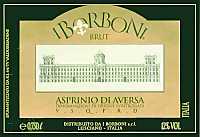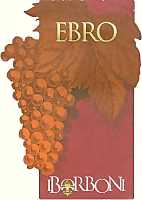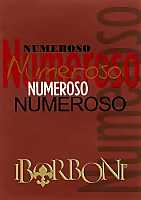|
Among the ancient and historical autochthonous grapes of Italy, a relevant place
certainly is occupied by Asprinio, whose qualities were already known in Roman
times and many authors - including Pliny the Elder - praised its wines in their
writings. The indisputable homeland of Asprinio grape is the territory of Aversa
- in the province of Caserta, Italy - where it is still being cultivated today
with the traditional method of vite maritata (married vine), a typically
Etruscan viticultural system in which the vine is trained in trees having long
trunks, usually poplar. Despite the system is now less and less used, it is
still possible to see - by traveling in the countryside neighboring Aversa - the
evocative view of the so called alberate Aversane (Aversan trees) which
point high to the sky and even reaching a height of 15 meters (about 50 feet).
In this land works since about one century the winery of Numeroso family which
always paid a particular attention to Asprinio, the local and historical white
berried grape.
|
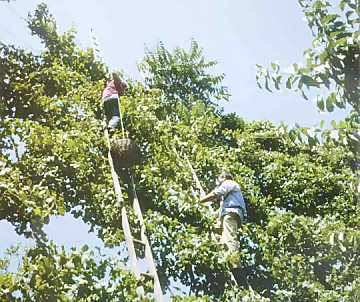 | |
| The harvesting of “vite maritata” | |
|
The winery of Numeroso family - owners of “I Borboni” branding - was
established in the beginning of 1900's and since those times they were involved
in the cultivation of Asprinio by using the traditional system of “alberata”.
The trend for a massive bulk production - typical in the 1960's - converted the
Numeroso winery in grapes providers for a very famous Italian spirit and liquor
producer which used the grapes for the production of sparkling wines and
brandies very renowned at those times. The first and fundamental change towards
a quality production was thanks to the intuition of Mr. Gabriele Lovisetto - a
former director of Buton - who at the beginning of 1970's convinced the Numeroso
family to make drastic changes and innovations in the vineyards, by replacing
the traditional “alberata” system with modern viticultural techniques. At the
end of 1970's Numeroso winery begins the first experimentations about making
sparkling wines with Asprinio and - encouraged by the first results - in 1982
decided to establish the “I Borboni” winery. It was during this important
phase that Cavaliere Nicola Numeroso showed all of its tenacity and decided to
concentrate his efforts on the revaluation of Asprinio, which at those times was
seriously in danger of extinction from the countryside of Aversa. The results of
his efforts were awarded with the recognition of IGT rank (Indicazione
Geografica Tipica, Typical Geographic Indication) and later in 1993 with the
recognition of Denominazione di Origine Controllata (DOC, Denomination of
Controlled Origin) Asprinio di Aversa.
In 1998 the Numeroso restored the family's palace in the historical center of
Lusciano, built on a tufa cave, and therefore it could be used again as the
cellar for the winery. In this way the Numeroso family restores the traditional
wine making technique of Asprinio which was done in caves - dug 13 meters deep
under houses (about 43 feet) - capable of offering unique and particular
conditions suited for the keeping of wine, as well as ensuring the constant and
adequate levels of temperature, humidity and light all year long. With the
restoration of the ancient and traditional caves, Numeroso family intended to
revaluate and keep their bonds with the most typical tradition of Asprinio wine
making, even though, as a matter of fact, this a source for many difficulties in
the many phases of processing, while, on the other hand, ensuring a better
typicality and respect of the product.
|
| 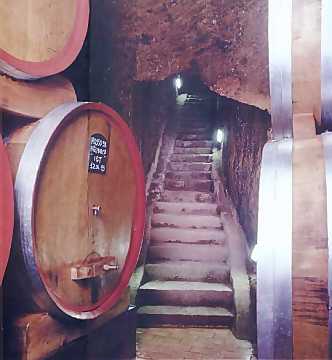 |
| An underground cellar at I Borboni |
|
Asprinio is a very ancient grape and many are the theories about its origin.
What it is certain is that wines produced with this grape were mentioned by many
authors in the course of history and its quality were praised and appreciated in
the Campania region and elsewhere. It seems Asprinio was already present in the
Aversa territory since Etruscan times where it was probably destined to the
production of vinegar and in later times was particularly appreciated for its
natural slightly sparkling wines, slightly sour and thirst quencher
(Asprinio in Italian means slightly sour). The traditional viticultural
system for Asprinio was the so called vite maritata - today defined as
alberata Aversana - a tradition introduced in this area by Etruscans and
that was usually common in all the other areas where this ancient people lived.
The system consists in having the vine climbing a live support which
usually is a poplar tree. The systemvite maritata system was so spread in
the Aversa territory that attracted - of course - the astonishment and wonder of
the visitors in past times.
The most suggestive moment was represented by harvesting. Around the middle of
September, skilled vintners gathered in the countryside with their very tall
ladders - about 30 centimeters wide (about 11 inches) with steps about 40-50
centimeters apart (15-20 inches) - which they used to carry in perfect vertical
balance on their shoulders. The ladders were leaned on the tall poplar
trees, they climbed up to the top and began to harvest grapes from the top of
vines. At the top of these ladders, they filled the traditional baskets and
with a rope were lowered to the ground where women and children emptied the
baskets in casks. The harvested grapes were then pressed by using the
traditional press and the vinification was done in the underground cellars of
the countryside of Aversa - caves dug on tufa rock and about 10 meters deep
(about 32 feet) - in which the must was fermented and then transformed into
wine.
The commitment of Numeroso family to Asprinio grape is well represented by the
wines they make. In the I Borboni winery are produced many styles of Asprinio
including a sparkling wine and a sweet wine. The pomace of this grape is also
used for the production of grappa, the most famous Italian brandy. Two are the
wines produced with this grape: Asprinio di Aversa “Vite Maritata” and
Asprinio di Aversa “Santa Patena”, the former being aged in steel tanks
whereas the latter being aged in oak casks. Ebro is a sweet wine made from
Asprinio and ages in cherry wood cask, interesting and particular for its
aromas. With Asprinio is then produced a sparkling wine - I Borboni Brut -
elaborated with a long Charmat process. The winery also produces wines with the
traditional grapes from Campania, such as the white Coda di Volpe - used for the
production of Lunajanca - and the red berried Aglianico, used for the production
of Rivolta. The production of I Borboni is completed by Numeroso Rosso, a red
wine produced with Aglianico, Cabernet Sauvignon and Merlot, aged for 6 months
in oak cask and aged for 6 months in bottle.
|



